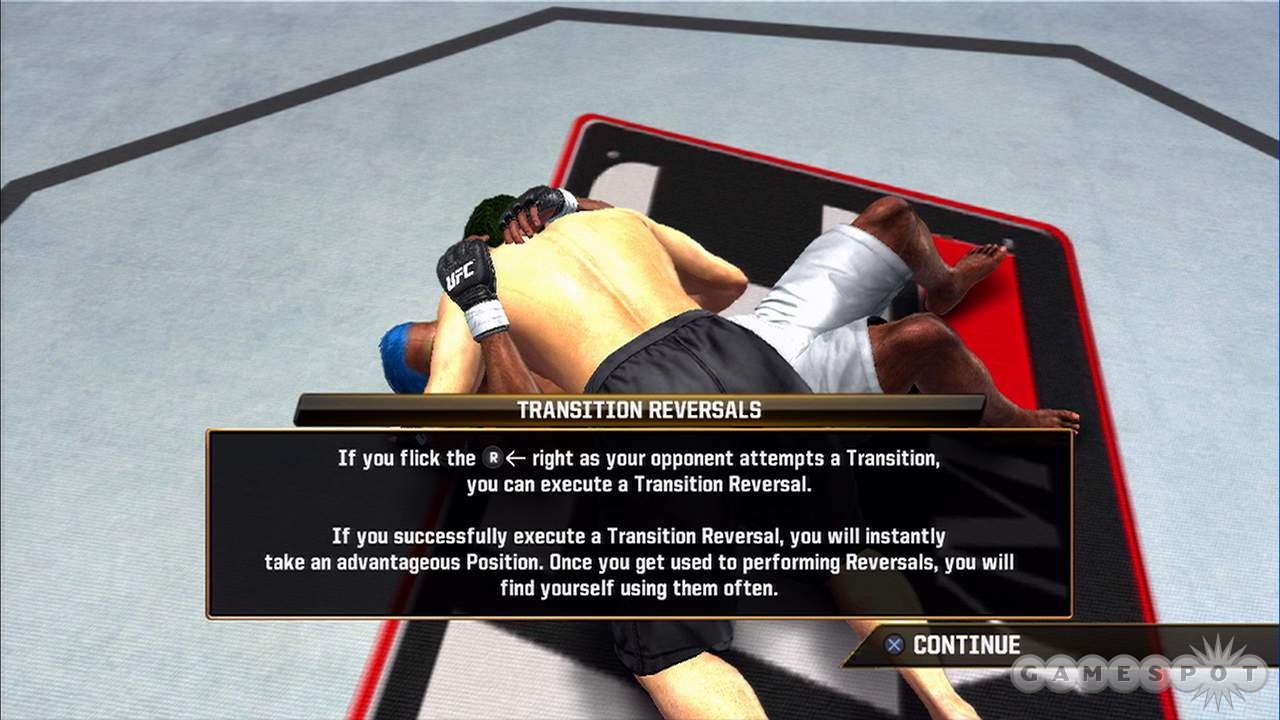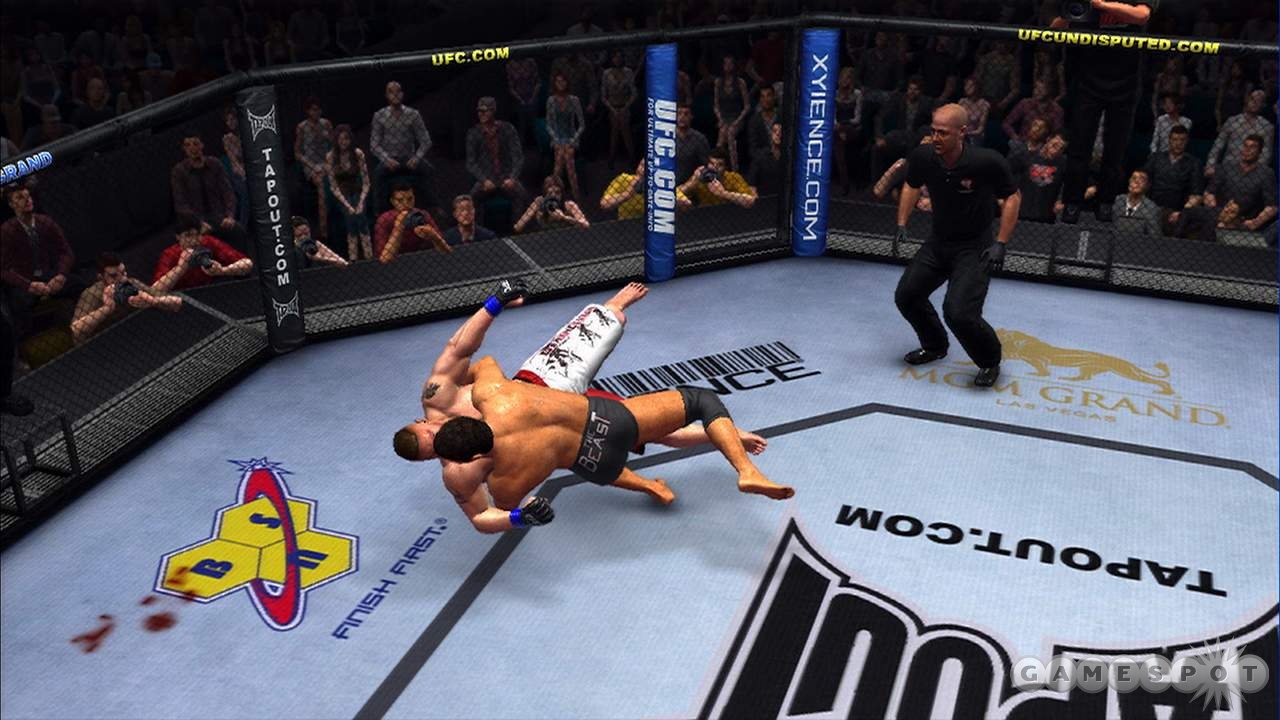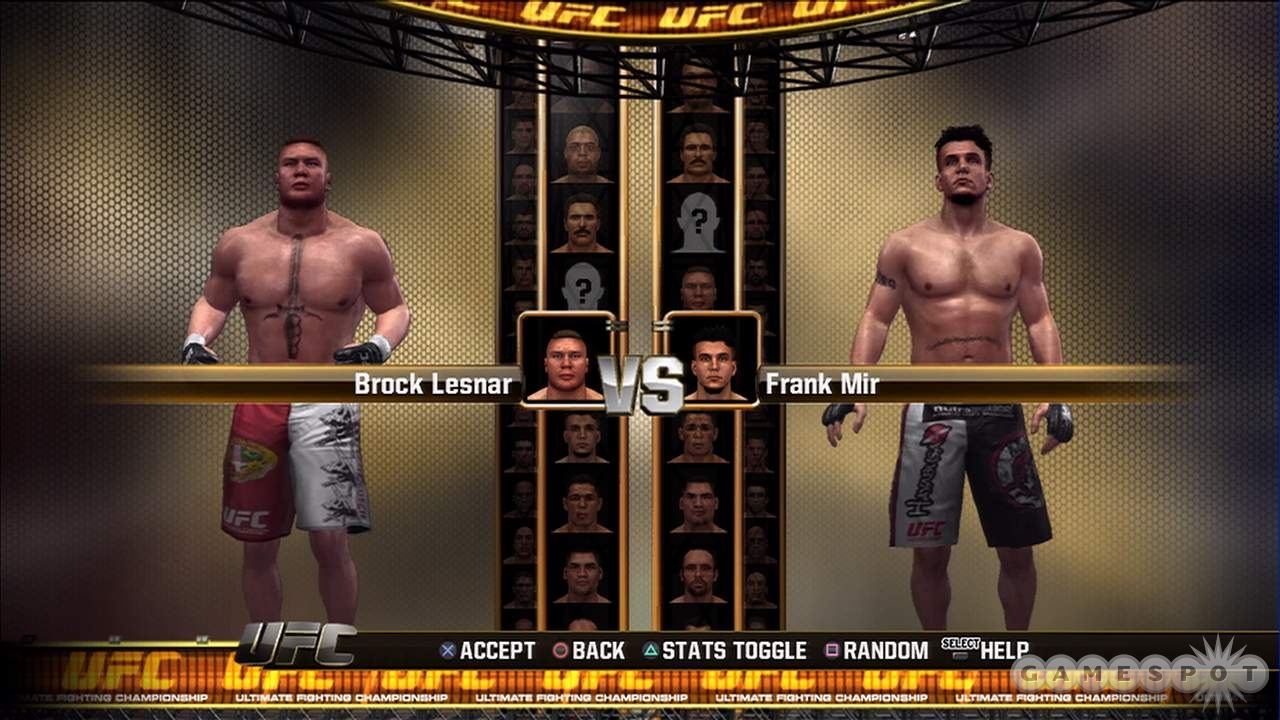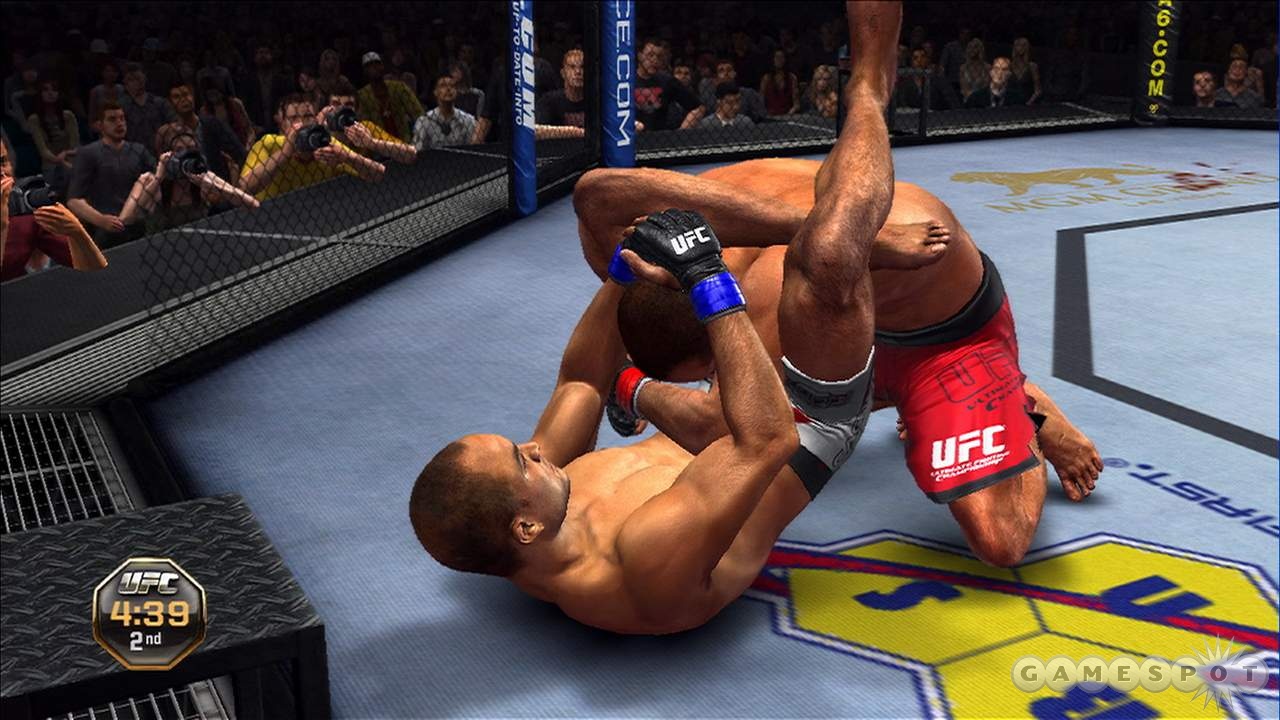Inside the octagon, there really wasn't a lot wrong with UFC 2009 Undisputed, which makes it all the more impressive that the combat in UFC 2010 Undisputed is so much better. New features and improvements aren't confined to the cage, either. When you're not busy punching, pummeling, or posturing, you can create a custom fighter who's no longer restricted by styles, play through a far less clunky (though still problematic) Career mode, and shop for trading cards and unlockables using points earned in all-new modes. Some of the new features have come with problems, but despite some drawbacks, UFC 2010 Undisputed is definitely a bigger and better game than its predecessor. Its fighting system is deep, but it's also accessible enough that you don't need to be a fan of mixed martial arts to enjoy it.
Regardless of whether or not you played last year's game, you'd do well to check out UFC 2010's Tutorial mode before jumping into the octagon to do battle with one of the 100-plus (as opposed to last year's 41) UFC fighters. The mostly intuitive controls are largely unchanged: Your limbs are still mapped to the four face buttons, shoulder buttons are still used for blocking and modifying attacks, and the right analog stick still has a number of different uses, depending on whether you're fighting stand-up, in a clinch, or on the ground. There are several new techniques and strategies for you to master this year, though, and while none of them are complicated, you're better off learning about them in the impressively thorough tutorial than in a fight when one of them is used against you.
Depending on your play style, the most significant change during fights is that the octagon itself now comes into play. When you get your opponent in a clinch and force him up against one of the cage walls, it becomes harder for him to defend himself as you gain more leverage for attacks. The walls can also come into play during takedown attempts and while wrestling on the ground, which makes this a much more realistic representation of the UFC than its predecessor. The new sway system is similarly game changing because you can evade attacks simply by leaning in one of four directions. Performed by holding down a trigger button and tapping the left analog stick that's usually reserved for movement, sways make it easier for you to stand your ground without having to resort to blocks while an opponent is on the offensive. It's a risky tactic, but the payoff for a perfectly timed sway is that you get to launch a powerful counterattack as you return to your original stance.
Risk-versus-reward mechanics also have an impact on the mat, where the ground-and-pound strategy that proved so effective last year has been made a little more challenging to use. You can still take an opponent to the ground and transition between different positions in an attempt to get a full mount, but you need to "posture up" before you can land really powerful blows, and when you do that, it becomes easier for your opponent to escape. Furthermore, it's now easier for the guy with his back on the floor to neutralize the guy on top by grabbing hold of his head and--if it seems like the best available option--waiting for the referee to stand both fighters up again. Alternatively, regardless of whether or not you're on top, you can try to submit your opponent.

After initiating one of the numerous different submissions with a quick click of the right analog stick, both players then rotate the stick as quickly as possible in an attempt to end the submission favorably. This inelegant system (referred to in-game as "the shine") works in much the same way that it did last year, except that as the guy being submitted, you now have to watch for your opponent transitioning from one submission hold to another. If that happens, you need to shine in the opposite direction. If you fail to do so, you're treated to an extreme close-up of the improved fighter likenesses and animation as the camera zooms in--getting closer and closer as the submission looks increasingly likely to end the fight. The improved visuals and camera work make the ground game more compelling and even a little easier to understand than it was last year, but if you prefer strikes to submissions, there's a good chance you'll still do your best to avoid it.
The UFC 2010 roster has plenty of fighters to choose from to suit every play style. There's no easy way to figure out which fighters specialize in which fighting styles. This is unfortunate if you don't follow the sport, but the vast majority of these guys are such well-rounded mixed martial artists that you can still fight effectively even if your chosen fighter's style is nothing like your own. One way to avoid any of this confusion, of course, is to create your own character from scratch, either as a finished fighter that's ready to go toe-to-toe with the pros or as a work-in-progress that you subsequently build up in the lengthy Career mode. Either way, it can be a time-consuming process because while your choices for variables like stance, voice, celebration, and nickname are limited, the options get much more granular when you start using sliding bars to tweak the appearance of your fighter's facial features and such. When it comes to your created fighter's stats, you get two distinct pools of points to spend. One pool can be spent on a combination of strength, speed, and cardio attributes; the other pool can be distributed between no fewer than 16 offensive and defensive skills. These skills determine your fighter's strengths and weaknesses because, for example, if you want to put a lot of points into making sure that his punches and kicks are lethal, you might have fewer points to spend on things like submissions and takedowns.
Unlike their counterparts in last year's game, UFC 2010 fighters aren't limited to using one grappling style along with one striking style. If you're creating a finished fighter, you choose from one of nine "technique templates" (Japanese MMA or Boxing, for example) and then have the option to customize your repertoire by trading in the moves that you don't want for points and then spending those points on moves that you do want. It's a great system because it lets you create fighters that specialize in your favorite moves--even if those moves span a number of very different disciplines. Career mode takes a similar approach, except that you don't even get to choose a technique when creating your character; you start out as something of a jack-of-all-trades and then earn skill points and new moves by taking part in training activities between fights.

Last year's Career mode was bogged down with unwieldy menus to the point that you spent more time navigating them than you did inside the octagon. Thankfully, that's not the case this year, but while the Career mode is much-improved and introduces some good features, it still has its fair share of problems. One neat change is that rather than being thrust into the UFC from day one, you now get to take part in up to five amateur fights (these are a great opportunity to experiment with the four difficulty settings) before turning pro and competing in the World Fighting Alliance. The WFA fighters aren't nearly as formidable as the guys in the UFC, so beating them and getting invited to join the UFC is just a formality. The important thing at this early stage of your career is that you use the weeks between fights wisely; otherwise you're liable to get destroyed in your first Ultimate Fight Night undercard. Sadly, while it's more important than ever and has been improved somewhat, training in UFC 2010 still isn't much fun. Strength, speed, and cardio training are still entirely menu driven; the most effective way to spar is to employ cheap tactics, and visiting camps to learn new moves is more often frustrating than it is fun. You need to devote a lot of time to training in Career mode this year because even as a young fighter, any stats and skills that you don't invest points in on a regular basis start to deteriorate.
On paper, the new skill-deterioration system sounds like a great idea. After all, it makes sense that you'd lose skills you neglect to work on over time. The problem is simply that this idea hasn't been implemented or explained anywhere particularly well. To avoid letting your skills deteriorate, you must regularly spend at least one point on each and every one of them, at least until you reach the deterioration-proof ratings of 30, 50, and 70 that they'll never drop below. Exacerbating this issue is the fact that you can only earn skill points in sparring sessions, which leave a lot to be desired.
After a sparring session, skill points are awarded by using simple math that amounts to little more than subtracting the number of times you were hit from the number of times that your hits landed, rather than how effective you were as a fighter. Your sparring partner has no desire to be used as a punching bag, so if you try to fight the way you would normally, you might find that the number of points you earn isn't even close to the 16 that you need to invest one in each skill. The auto-sparring option forgoes the 90 seconds that you spend in the octagon if you choose to spar manually, but it awards you such a small number of skill points that it's not a good option. Your best bet, sadly, is to employ cheap tactics that make it very easy for you to land blows while being on the receiving end of very few. Use a simple takedown to get your partner on the floor, spam punches while he struggles, earn points for those punches and for his failed attempts to get back to his feet, and then repeat this sequence when he inevitably succeeds. It's not challenging and definitely not fun, but it's extremely effective.
Visits to other camps that you make when you want to add a new move to your arsenal are much more challenging, or at least some of them are. Depending on the type of move that you want to learn, you might be required to do something as simple as landing a number of two-hit combos or something as challenging as forcing a partner to submit multiple times in a short amount of time. Your progress carries over multiple sessions, so it's possible to spend two or three training weeks learning a move if you don't manage it in one. Just make sure you remember what you were learning and at which of the 27 camps you were learning it because there's no easy way to return when you're ready for your next lesson.
When you're not training or competing, it's generally because you're in need of rest, which--like just about everything else in Career mode--takes a full week. This includes media-related activities like making fight predictions and sparring in front of the press. The need to balance your conditioning with your fatigue level and to keep them as close to 100 and zero, respectively, on the week of your fight is a constant and realistic concern. Other stats to keep an eye on in Career mode include your popularity (as influenced by media activities, post-fight interviews, and the like), which has an impact on sponsorship deals, and your cred. Cred goes up after every fight (depending on the result and on which sponsor logos you adorn your shorts with) and unlocks gym upgrades and new sparring partners. These make your training more effective and raise the level caps on your physical attributes and skills. Despite the aforementioned problems, it's certainly easy to get sucked into UFC 2010's 12-year Career mode. You always feel like you're progressing, and while the weeks in between fights aren't much fun, the fights themselves are still great, and it's always very satisfying to win because you feel like your hard work has paid off.

Outside of Career mode, there are plenty of other, less time-consuming modes for both solo and multiplayer sessions. Title mode challenges you to defeat between eight and 12 opponents to claim the title belt in your chosen weight class. The unlockable Title Defense mode pits you against 12 opponents in five-round championship fights that you must win back-to-back without ever losing. Event mode lets you create and play through your own multifight events or download lineups for upcoming UFC events and play through them. Tournament mode supports custom knockout competitions for up to 16 players on one console. None of these modes do anything that's remarkable, but all are good ways to enjoy the great mixed martial arts combat.
If you're a fan of the UFC, you're sure to get a kick out of the other single-player mode as well. Ultimate Fights affords you an opportunity to relive or rewrite history in a number of classic fights (15 on the Xbox 360, 20 on the PlayStation 3) that date as far back as 2005's UFC 51. There are nine challenges to complete for each fighter, which include a good combination of easy (perform three successful takedowns) and reasonably difficult (win by rear naked choke in first round) objectives. Successful completion of these challenges provides one of a few different ways that you can earn credits to spend on additional customization options for your fighters, and it also unlocks highlight videos of the fights in question, which look great on the PS3 but are poorly compressed on the Xbox 360. Incidentally, the PS3 version also includes five full-length, high-definition UFC fights on the disc.
UFC 2010's online offering is sadly much the same as it was last year. More often than not, ranked and unranked exhibition matches suffer from noticeable lag, the quick-match option doesn't reliably connect you with opponents, and there's no support for tournaments, spectators, or any of the other neat options that you might hope to find in a modern fighting game. Other than the aforementioned option to download event cards, the only additions to this year's online offering are a medal system that recognizes and keeps a record of your online accomplishments and an online fight camp system that--outside of team leaderboards--does very little that's worthwhile. One of the more interesting features of online camps should be the training sessions where you pair up with another team member, but in practice, they're just pointless and frustrating. You don't always get credit for completing the very specific exercises that your presented with, playing as the trainer involves a lot of standing around and letting yourself get hit in the hope that you can gain a meaningless trainer level online, and even if you succeed as the trainee, your only reward is a miniscule amount of cred that's unlikely to have any impact on your fighter in Career mode.

Clearly, UFC 2010 Undisputed is a game with its fair share of problems. You shouldn't let that put you off, though, because this is also a game that brilliantly re-creates the mixed martial arts combat that has made the UFC so popular and that boasts a roster of more than 100 great-looking contemporary fighters (as well as three bonus classic fighters on the PS3). Last year's problems have mostly been addressed, new problems have been introduced, and the end result is a game that--much like its predecessor 12 months ago--is difficult to fault inside the octagon but falls short of expectations between fights.
Editor's Note: The preceding review previously contained erroneous information about the visibility of the new skill deterioration system in Career mode. GameSpot regrets the error.